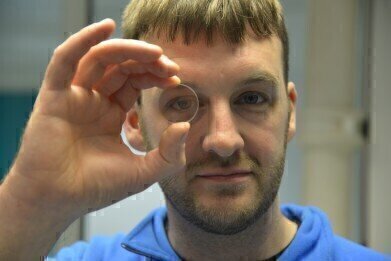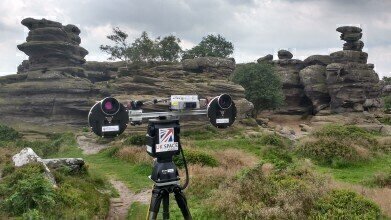-
 Dr Matt Gunn
Dr Matt Gunn -
 PanCam at Brimham Rocks
PanCam at Brimham Rocks
News & Views
Eye-Test for ExoMars in Iceland
Aug 21 2017
A camera system, under development by a team led by UCL’s Mullard Space Science Laboratory and that will feature on the European Space Agency’s 2020 mission to Mars, took a trip to Iceland along with scientists from Aberystwyth University and the University of St Andrews, as work continues to develop the capability of the instrument that will be the eyes of the ExoMars Rover. Dr Matt Gunn and colleagues from the Institute of Mathematics, Physics and Computer Science at Aberystwyth, are part of an international team developing and testing the PanCam’s data processing pipelines to enable the camera to capture accurate colour images and 3D measurements of geological features on Mars.
Inspired by stained glass technology used in medieval cathedrals, Dr Gunn’s team has built a colour calibration target that will retain the vibrancy of its coloured glass discs despite the very high levels of ultra-violet radiation on the planet.
The Aberystwyth team has also developed a Rover Inspection Mirror that will enable PanCam to capture “selfies” of the rover to check itself for damage or problems during the mission.
During a prior field test in Brimham Rocks in Yorkshire, the team tested PanCam’s 3D measurement capabilities. Developed to enable geologists to remotely identify rock formations that might indicate the previous existence of liquid water, Dr Gunn has been working on calibration and processing needed to convert the raw images into accurate full colour images of the rocks.
The Iceland mission was focused on testing how PanCam records colours using its advanced multispectral technology. Whilst human vision sees images using three colours - red, green and blue - PanCam’s cameras are able to ‘see’ in 22 different colours, including infra-red, which is invisible to the human eye.Working on Iceland’s northern coast, Dr Gunn investigated the camera’s ability to register subtle colour differences in a landscape that is largely devoid of green plants.
Just before the expedition Dr Gunn said: “Iceland has been chosen for this work as we needed an environment that was not dominated by green plants full of chlorophyll, and had the right type of rock. The camera is highly sensitive as the scientists who work with these images will be looking for very subtle changes in colour. These images are not ordinary colour photographs; they will be used to work out the different types of rocks on Mars. It is known that some rocks form in wet environments, so accurately interpreting the images may help mission scientists to pinpoint where to look for possible signs of life.”
It was the second time PanCam has been tested in Iceland. Further tests are scheduled for the next couple of years to other remote locations which may include Utah in the USA and the Atacama Desert in south America.
Professor Andrew Coates of UCL’s Mullard Space Science Laboratory, lead investigator for PanCam on the ExoMars 2020 rover, said: “Field trials like this are an important part of preparing the team for science and operations on Mars. The Aberystwyth University PanCam Emulator is a key simulation of the real instrument we are building. We can’t wait to see the data from the trials, and from PanCam on Mars after the rover lands in 2021”.
The work on PanCam by Dr Gunn and colleagues at St Andrews is being funded by the UK Space Agency.
Digital Edition
Lab Asia 31.2 April 2024
April 2024
In This Edition Chromatography Articles - Approaches to troubleshooting an SPE method for the analysis of oligonucleotides (pt i) - High-precision liquid flow processes demand full fluidic c...
View all digital editions
Events
Apr 22 2024 Marrakech, Morroco
Making Pharmaceuticals Exhibition & Conference
Apr 23 2024 Coventry, UK
Apr 23 2024 Kintex, South Korea
Apr 23 2024 Seoul, South Korea
Apr 24 2024 Jakarta, Indonesia







.jpg)









